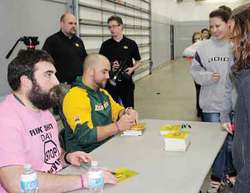Pipestone Flyer
Gord Hinse, Offensive Lineman & Ryan King, long snapper, Edmonton Eskimos sign autographs. Photo by Barry McDonald.
“In total 639 shirts have gone out into the community again this year and 1000 pink shirt wrist bands. We are just under 2000 shirts in 3 years – lots of pink out there.” Debbie Pearson, Fund and Communications Coordinator, Boys and Girls Club of Wetaskiwin, and one of the founders of Pink Shirt day, is very pleased with the growing participation.
In December of 2011, the Pink Shirt Day Coalition was formed in Wetaskiwin to spread the anti-bullying message; that bullying would not be tolerated in our community schools, our playgrounds, our businesses, our homes or on our streets.
Historically, pink has always been a symbol of femininity. So much so that in-the-past people felt it was unacceptable for a ‘real man’ to wear pink. It can be very humbling and in many cases embarrassing to wear something that has been labeled as being feminine.
In recognition of Pink Shirt Day, more than 1600 supporters throughout Wetaskiwin and region adorned pink t-shirts or wore pink wrist bands as a symbolic and visible method to take a year-round stand against bullying. Interested schools, businesses, organizations and individuals supported the campaign. Pink shirts and wrist bands appeared throughout the community; many of the banks, Dr. Hewko’s office, Community Corrections, Wetaskiwin Hospital, City of Wetaskiwin, NorQuest College, Horizon Centre, WDACS and of course many individuals and other groups.
Approximately 650 junior high students converged on the Wetaskiwin Drill Hall on February 26th to hear a presentation by Edmonton Eskimo football players Offensive Lineman, Gord Hinse and Long Snapper, Ryan King about their careers and bullying. The students were from the CB McMurdo, Norwood, PLRS (Pigeon Lake), Buck Mountain, Ermineskin Elementary, Gwynne, Clear Vista, Parkdale, Centennial, Queen E., EJSH (Ermineskin JR/Sr High) and Sacred Heart schools.
Wetaskiwin Hospital staff rallied behind Pink Shirt Day
Staff in the Wetaskiwin Hospital led by Linda Armson, joined the campaign against bullying. “Last year I knew about it and just thought with all our hospital workers we could use it (awareness about bullying) in a place like this too. So I approached Debbie (Pearson) and talked to her and got an order form. Last year I just ordered for the kitchen and started it as a ‘kitchen group’ but others were wearing them so at the end of the campaign we gathered for a picture. We had 36 last year and a few more this year.” Armson explains her commitment to the campaign. “Bullying is a very devastating thing and happens everywhere, even in the workplace. Whatever we can do to reduce bullying, to make people aware of it, is important. It’s a very difficult thing because bullies don’t like to be approached but if they aren’t….”
Bullying is defined in Wikipedia as: “Bullying is the use of force, threat, or coercion to abuse, intimidate, or aggressively impose domination over others. The behavior is often repeated and habitual. One essential prerequisite is the perception, by the bully or by others, of an imbalance of social or physical power. Behaviors used to assert such domination can include verbal harassment or threat, physical assault or coercion, and such acts may be directed repeatedly towards particular targets. Justifications and rationalizations for such behavior sometimes include differences of class, race, religion, gender, sexuality, appearance, behavior, strength, size or ability. If bullying is done by a group, it is called mobbing. ‘Targets’ of bullying are also sometimes referred to as ‘victims’ of bullying.”
Edmonton Eskimo football players, Hinse and King were very emphatic that in today’s culture, in addition to traditional forms of bullying, cyber bullying on Facebook, email, or by texting has become a significant issue. They were also very clear that